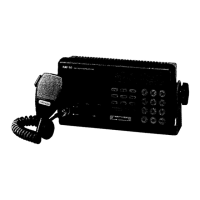
Do you have a question about the Raymarine Ray 90 and is the answer not in the manual?
| Type | Marine VHF Radio |
|---|---|
| Handset Connectivity | Wireless |
| Channels | International |
| GPS | Yes |
| Range | Up to 5 nautical miles |
| Display | LCD |
Device is an aid to navigation; user is responsible for prudence and judgment.
Warranty terms for dealer distributor and light marine products.
Exclusions and limitations on the warranty coverage.
Overview of the RAY 90 marine radiotelephone's capabilities and features.
Lists key features of the RAY 90, including construction, remote units, and scanning modes.
Detailed technical specifications of the RAY 90 radiotelephone.
Covers frequency range, channel count, input voltage, current, impedance, stability, etc.
Details the technical specifications of the transmitter.
Details the technical specifications of the receiver.
Specifications for the NCH-308 remote unit.
Instructions for safely unpacking and inspecting the RAY 90 transceiver.
Lists all items included with the RAY 90 transceiver and optional accessories.
Guidelines for choosing the optimal location to mount the RAY 90.
Instructions for physically mounting the RAY 90 transceiver using the yoke or kit.
Guidance on proper antenna installation for optimal transceiver performance.
Details the rear panel connections for ANT, GND, DC 13.6V, and EXT SP.
Explains MIC connector pin assignments and remote microphone wiring.
Explains connecting up to 4 remote stations, using junction boxes for multiple units.
Precautions and mounting instructions for the RAY 90 remote unit.
Procedure for assigning ID numbers to multiple remote units using S201.
Description of the RAY 90's front panel controls and their functions.
Step-by-step guide for operating the RAY 90 radiotelephone.
Instructions for powering up the RAY 90 and managing audible feedback.
Procedure for adjusting the audio volume level.
How to adjust the squelch control to eliminate static.
Steps for selecting USA or International channels using numeric keys.
Procedure to select weather channels using the I/U and P/W keys.
How to activate and use the weather alert function for warnings.
How to switch between 1-watt and 25-watt output power.
Details Dual Watch, All Scan, and Select Scan modes.
Procedure for recalling private channel numbers.
Instructions to clear all memory channels.
Procedure for selecting Canadian channels and their indication on the LCD.
How the master unit operator controls remote units and retakes control.
Instructions to turn off or restore panel backlighting.
How to connect and use the optional handset as a telephone receiver.
Description of the operating controls of the RAY 90 Remote Unit.
Details functions controlled by the remote unit keypad.
Procedures for preparing, controlling, and setting channels for remote units.
How to activate and use the intercom function between master and remote units.
Lists USA VHF marine radio channels, frequencies, and duplex modes.
Lists International VHF marine radio channels, frequencies, and duplex modes.
Describes the two main sections of the RAY 90: Control and TX/RX/Synthesizer.
Details the keyboard, CPU, and I/O interface components of the control unit.
Explains isolation by opto-coupled devices and the function of analog switches.
Details the TX/RX circuits, referring to block diagrams.
Describes the receiver's dual conversion super-heterodyne design and filters.
Details the first mixer stage and its associated bandpass filters.
Explains the 2nd mixer, IF amplifier, discriminator, and squelch circuitry.
Describes demodulation, low-pass filtering, de-emphasis, and noise detection.
Explains how voice signals are processed for transmission.
Describes the Voltage Controlled Oscillator and its role in modulation.
Explains the APC circuit for regulating output power levels.
Details the PLL synthesizer for generating receiver and transmitter frequencies.
Purpose of section is to provide servicing instructions to technicians.
Monthly procedures to minimize equipment failure and ensure optimum performance.
Lists test equipment and procedures for verifying adjustments.
Procedures for aligning the receiver section using test equipment.
Procedures for adjusting transmitter output power and frequency deviation.
Troubleshooting chart to isolate faults to functional areas.
Provides outline drawings for the RAY 90, Handset, Remote Unit, and Junction Box.
Lists part numbers for the Master Radio, Remote Station, and Handset.
Index of available drawings, schematics, and PCB layouts for various units.
Block diagram illustrating the internal structure of the NCH-308 Remote Unit.
Provides FCC rules relevant to recreational boaters using VHF marine radios.
Explains who the rules apply to and what they cover.
Details requirements and application procedures for ship station licenses and RPs.
Instructions on radio type, power output, required channels, and self-installation.
Guidance on maintaining watch, power usage, calling procedures, and channel changes.
Lists types of transmissions that are not permitted.
Details the necessity and content of a radio logbook.
Information on obtaining FCC rules and Volume IV.
Requirement to make station and records available for FCC inspection.
Explains potential FCC actions for violations, including fines and license revocation.
Step-by-step guide for initiating contact with other vessels.
Procedure for making calls via a public coast station.
Information on marine emergency signals and their priority.
Detailed steps for reporting a distress situation via radio.
Guide to proper channel usage for various types of marine communications.
Guidance for using Channel 16 in distress and emergency situations.
How to initiate communications on Channel 16 and working channels.
Importance of monitoring Channel 16 and working channels when not transmitting.
Use of Channel 6 for safety messages and Coast Guard coordination.
Working channel (22) for exchange of communications with U.S. Coast Guard stations.
Use of Channel 13 for maneuvering and directing vessel movements.
Channels for operational handling, movement, and safety of vessels in ports.
Channels for recreational boats for fishing, rendezvous, and berthing information.
Channels for vessels engaged in commercial transport or servicing.
How to place telephone calls via the marine operator.
Channel 17 for coordination with state and local governments.
Receiving continuous weather information from NOAA on WX channels.
Receiving information on weather, sea conditions, and hazards to navigation.